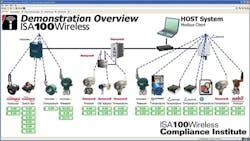Ian Verhappen is an ISA Fellow, Certified Automation Professional and a recognized authority on industrial communications technologies with 25+ years' experience. You can contact him at [email protected], via his blog at community.controlglobal.com/kanduski, or check out his Google+ profile.
Last year at this time, I wrote about WirelessHART, ISA-100.11a and WIA-PA, the three wireless standards targeted at process automation. Since then, each has evolved in the IEC standards process, and in compliance testing and interoperability. I have little information on WIA-PA from China, so this column looks at the two North American options.
There are various levels of hardware and software in any protocol. The OSI seven-layer model reinforces this concept. So, for any device, the stack and device testing are different. The stack test confirms the communication characteristics, and device testing checks for interoperability. A common way to test interoperability is a "plugfest," where devices are tested for interoperability with emerging standards by physically connecting them. If systems are standards-compliant, they should function as expected when plugged together. A plugfest is more of a down-and-dirty approach in contrast to the certification process of running test programs and test equipment.
The Wireless Compliance Institute (WCI) held a wireless plugfest to test device interoperability along with emerging standards. The ISA-100 Plugfest had four hosts: one system each from Yokogawa and Nivis, and two Honeywell systems.
Source: Wireless Compliance InstituteThe Wireless Compliance Institute (WCI) reported in January about the plugfest it hosted in Los Angeles a month earlier to confirm interoperability of a number of devices.
In the case of a wireless plugfest, four components need to be considered:
- Provisioning — preparing a device to join a network. Provisioning does not include device configuration, which is done from the host once communications have been established.
- Networking—routing of the signal using mesh, star or other configurations.
- Device — read/write and operate the device over the wireless network, including configuring it.
- Data — publication rates to confirm information is transmitted when it is required.
The ISA-100 Plugfest had four hosts. Yokogawa and Nivis both used the Freescale chipset, and two Honeywell systems employed the Texas Instruments chip. Devices were provided by a range of manufacturers.
Security is a key consideration for wireless systems, and since provisioning is where the devices are added to the network, it must be secure. Both ISA-100.11a and WirelessHART provide network IDs in a secure environment before connecting the device to the wireless network. ISA-100 uses Infrared Data Association (IrDA) or RS-232 cable, while HART uses a handheld or PC with HART modem requiring a physical wire connection.
Some added "glue" specifications have been written by WCI to integrate ISA-100.11a with other standards. For example, infrared provisioning was demonstrated as interoperable. This was accomplished by a WCI glue specification written by WCI members for an infrared, out-of-band channel used for provisioning that describes exactly how to integrate the ISA-100.11a standard with the IrDA standard.
Application configuration is fully specified by the ISA-100.11a standard, but is intended to be extensible from that base using device descriptors. Accordingly, the standard was extended with another WCI glue specification to allow interoperable extensions with industry-standard device descriptors EDDL (ISA-104). WCI plans to make the IrDA and configuration extension specifications available to non-members in 2012, meaning they'll likely be incorporated into the next revision of ISA-100.11a.
As indicated above, provisioning of HART gateways and devices require a physical connection via a HART modem to be added to the network. Once the HART modem is connected, the procedure is as follows: Add the WirelessHART Join Key, then the WirelessHART Network identification. (The Join Key and the Network ID identify the network as unique, and so allow only authorized devices to join. The Join Keys can be rotated within a network.) Select the process variables of one of the installed instruments to send, and select the update rate for the devices.
All wireless networks build from the network gateway outwards, so they have the necessary hops or links in place to create the equivalent of a routing table showing the path from each device to the gateway.
Once the information gets to the gateway, it still needs to be transmitted to the host control system. Neither HART nor ISA-100 has defined a backhaul protocol yet. HART documentation suggests using HPort, Modbus or EtherNet/IP. ISA-100 uses Modbus TCP, though work is at the request-for-information (RFI) stage of its development, and the committee is cooperating with Fieldbus Foundation under the auspices of the ISA-100.15 backhaul/backbone committee to better define this connection for wired and wireless backhauls. It's likely the backhaul will closely resemble the FF HSE specification.
The good news is progress continues on making industrial wireless systems, and this plugfest is one more step to increase overall reliability and confidence to use them in control systems.
About the Author
Ian Verhappen
ISA Fellow

Leaders relevant to this article:


